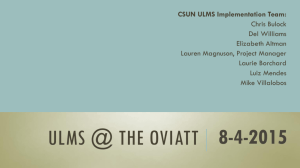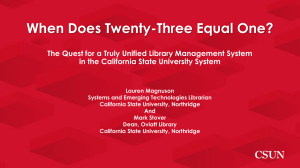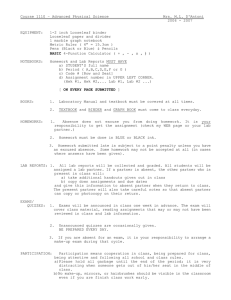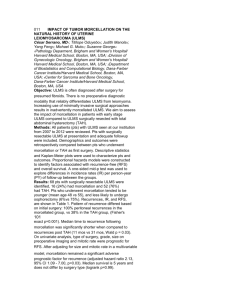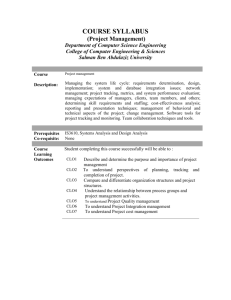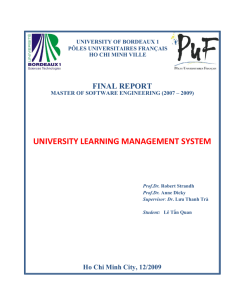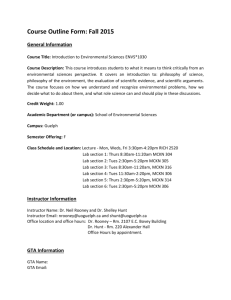Accounting Core Course Learning Outcomes Updated 9/26/15
advertisement
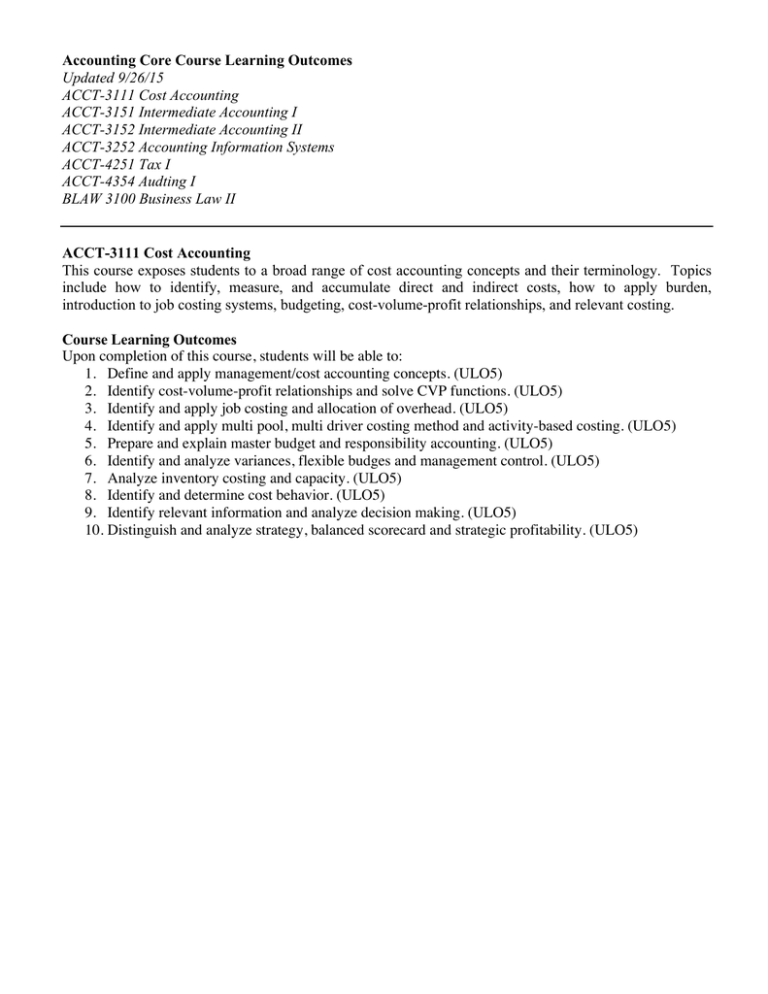
Accounting Core Course Learning Outcomes Updated 9/26/15 ACCT-3111 Cost Accounting ACCT-3151 Intermediate Accounting I ACCT-3152 Intermediate Accounting II ACCT-3252 Accounting Information Systems ACCT-4251 Tax I ACCT-4354 Audting I BLAW 3100 Business Law II ACCT-3111 Cost Accounting This course exposes students to a broad range of cost accounting concepts and their terminology. Topics include how to identify, measure, and accumulate direct and indirect costs, how to apply burden, introduction to job costing systems, budgeting, cost-volume-profit relationships, and relevant costing. Course Learning Outcomes Upon completion of this course, students will be able to: 1. Define and apply management/cost accounting concepts. (ULO5) 2. Identify cost-volume-profit relationships and solve CVP functions. (ULO5) 3. Identify and apply job costing and allocation of overhead. (ULO5) 4. Identify and apply multi pool, multi driver costing method and activity-based costing. (ULO5) 5. Prepare and explain master budget and responsibility accounting. (ULO5) 6. Identify and analyze variances, flexible budges and management control. (ULO5) 7. Analyze inventory costing and capacity. (ULO5) 8. Identify and determine cost behavior. (ULO5) 9. Identify relevant information and analyze decision making. (ULO5) 10. Distinguish and analyze strategy, balanced scorecard and strategic profitability. (ULO5) ACCT-3151 Intermediate Accounting I Focuses on the study of problems in financial accounting measurement, including an introduction to theory, presentvalue concepts and applications, current assets, including cash, receivable, and inventory valuation problems. Course Learning Outcomes CLO1: Is able to discuss and describe the purpose of a company’s basic financial statements along with being able to prepare the basic financial statements when presented with account balances (ULO5/UACC1). CLO2: Is able to discuss and describe Cash & Receivables as presented on the balance sheet along with being able to calculate the valuation of accounts receivable and notes receivable (ULO5/UACC1). CLO3: Is able to discuss and describe the various inventory cost flow assumptions (FIFO, LIFO, Average Cost, Specific Identification) along with being able to calculate ending inventory and cost of goods sold using the various cost flow assumptions under both periodic and perpetual methods in addition to being able to explain and calculate other valuation issues like: Lower of Cost or Market, Gross profit estimate and Retail inventory method (ULO5/UACC1). CLO4: Is able to discuss and describe the acquisition and disposition of PPE along with being able to calculate the valuation of PPE along with being able to describe and calculate depreciation expense using the various depreciation methods and also being able to describe and calculate impairments and depletion (ULO5/UACC1). CLO5: Is able to discuss and describe the various types of intangible assets in addition to being able to calculate the value of the intangible assets in addition to calculating impairment of the intangible assets (ULO5/UACC1). CLO6: Is able to discuss and describe current and long-term liabilities and contingencies in addition to being able to calculate the valuation of bonds payable and long-term notes payable (ULO5/UACC1). TOPICAL OUTLINE/COURSE CONTENT • Ch 1 (Financial Accounting & Accounting Standards) • Ch 2 (Conceptual Framework for Financial Reporting) • Ch 3 (The Accounting Information System) • Ch 4 (Income Statement and Related Information) & Financial Statement Project Given Out • Ch 5 (Balance Sheet and Statement of Cash Flows) • Ch 6 (Accounting and the Time Value of Money) • Ch 7 (Cash and Receivables) • Ch 8 (Valuation of Inventories: A Cost Basis Approach) • Ch 9 (Inventories: Additional Valuation Issues) • Ch 10 (Acquisition and Disposal of Property, Plant & Equipment) • Ch 11 (Depreciation, Impairments and Depletion • Ch 12 (Intangible Assets) and Ch 13 (Current Liabilities and Contingencies) • Ch 14 (Long-term Liabilities) ACCT 3152 Intermediate Accounting II Focuses on measurement issues in financial accounting. Topics include stockholder’s equity with earnings per share, investments, revenue recognition, pension, leases, income taxes, statement of cash flows, and disclosure Expected Student Outcomes: Upon completion of this course, the student should be able to: 1. Demonstrate an understanding of generally accepted accounting principles governing the topics studied and 2. Assess the implications of significant judgments in the application of accounting standards. TOPICAL OUTLINE/COURSE CONTENT\ • Chapter 15 – Stockholders’ Equity • Chapter 16 – Dilutive Security & Earnings Per Share • Chapter 17 – Investments • Chapter 18 – Revenue Recognition • Chapter 19 – Accounting for Income Taxes • Chapter 20 – Accounting for Pensions & Postretirement Benefits • Chapter 21 – Accounting for Leases • Chapter 22 – Accounting Changes & Errors Analysis • Chapter 23 – Statement of Cash Flows • Chapter 24 – Full Disclosure in Financial Reporting ACCT-3252 Accounting Information Systems An overview of accounting information systems. Topics include both manual and computerized accounting systems. Coverage also includes the use of spreadsheet software for data collection, manipulation, filtering, sorting, and analysis. EXPECTED STUDENT OUTCOMES: Upon completion of this course, students should be able to: CLO1: Handle the process of the Accounting Information System Cycle. (ULO5) CLO2: Explain how the traditional Accounting Information System Cycle works. (ULO5) CLO3: Apply spreadsheet software to tasks in accounting, including analysis, design, and implementation. (ULO5) CLO4: Use commercial accounting software. (ULO5) CLO5: Identify and describe internal controls in both manual and computerized accounting settings. (ULO5) CLO6: Organize and complete tasks on time as required in the accounting profession. (ULO5) ACCT-4251 Tax I Covers the study of individual federal income taxation with an emphasis on the following topics: income, exclusions from income, deductions, exemptions, credits, property transactions, and depreciation. Explores the tax structure and its role, both as a source of revenue and as a device to control the economy. Emphasizes Form 1040 tax return preparation using tax preparation software including common schedules and worksheets. Topical Outline 1. Introduction to Tax 2. Tax Compliance, the IRS, and Tax Authorities 3. 4. 5. 6. 7. 8. 9. 10. 11. 12. 13. 14. Tax Planning Strategies and Related Limitations Individual Income Tax Overview Gross Income and Exclusions Individual Deductions Individual Income Tax Computation and Tax Credits Business Income, Deductions, and Accounting Methods Property Acquisition and Cost Recovery Property Dispositions Investments Compensation Retirement Savings and Deferred Compensation Tax Consequences of Home Ownership ACCT-4354 Auditing I Deals with the standards, concepts, objectives, techniques, reports, and ethics of both the independent and internal auditor. Special attention is given to statements on auditing standards, auditing procedures, statistical sampling, and EDP in auditing. PREREQUISITE: ACCT-3152, Intermediate Accounting II. EXPECTED STUDENT OUTCOMES (Course Learning Objective-CLO): CLO1: Is able to discuss and describe auditor’s responsibility to detect material misstatements in the financial statements and is able to identify risk areas that pose a major threat to the financial statements (ULO5/UACC1). CLO2: Is able to discuss and describe GAAS and PCAOB Standards and appropriately apply the standards to audit situations (ULO5/UACC1). CLO3: Is able to discuss and describe the various audit reports (opinions) and also identify required audit report from various audit situations (ULO5/UACC1). CLO4: Is able to discuss and describe the impact of Sarbanes-Oxley on the auditing profession and corporate governance and is able to apply Sarbanes-Oxley regulations to various audit situations (ULO5/UACC1). CLO5: Is able to discuss and describe the components of internal control and also identify areas of control deficiencies in various audit situations (ULO5/UACC1). BLAW 3100 Business Law II This course references the study of law relating to business organizations and the financing of transactions. Topics include partnerships, corporations, securities regulation, commercial paper, credit, secured transactions, and bankruptcy. COURSE OBJECTIVES: Upon completions of this course, the student is able to: 1. Discuss the “problems” posed by “international law” for American business by examining concepts such as local custom in light of the Foreign Corrupt Practices Act, and offshore financing and global securities markets. 2. Discuss the adaptability of law to new technology in a context such as electronic funds transfer and non-bank banks. 3. Apply this basic principles of law relating to organizing and financing a business organization to resolve or more importantly, to avoid legal problems. 4. Describe the pros and cons of the various forms of business organization and evaluate and evaluate the appropriateness of a given form to a given context. 5. Apply the basic principles of commercial paper law to resolve or avoid legal problems from either an enterprise or individual perspective. 6. Apply the basic principles of commercial law in the functional areas of credit, secured transactions and bankruptcy to resolve or avoid legal problems. 7. Discuss strategies to protect creditors using legal concepts like trade acceptances, secured credit, perfected security interests, priority distributions in bankruptcy, non-dischargeable debts and bankruptcy offenses as a bar to discharge. 8. Describe the statutory and common law liability of the accountant who provides or attests to erroneous financial information and understand the accounting practices which will avoid such liability. 9. Use critical thinking and reasoning skills to define the legal issues involved in a dispute, discuss the alternative outcomes, decide the issue, and effectively communicate such a well-reasoned conclusion in oral or written form. 10. Recognize that even though a legal decision is logically derived, laws like actions have consequences and what a law “has done” or “will do” must be considered. Topical Outline: • Forms of Business • Operations of Partnerships • Partnerships Dissolution • Limited Liability Partnerships • History of Corporations • Organization and Financing Structure of Corporations • Management of corporation • Shareholders rights • Securities Regulations • Administrative Law • Antitrust- The Sherman Act • Employment Law • Introduction to Credit • Bankruptcy • Negotiable Instruments • Negotiation and Holder in Due Course
